| 
The victory of the Parliamentarian New Model Army, under Sir Thomas Fairfax and Oliver Cromwell, over the Royalist army, commanded by Prince Rupert, at the Battle of Naseby (14 June 1645) marked the decisive turning point in the English Civil War.
Date
22 August 1642 – 3 September 1651
(9 years, 1 week and 5 days) English Civil War The English Civil War (1642–1651) was a series of armed conflicts and political machinations between Parliamentarians (Roundheads) and Royalists(Cavaliers). The first (1642–46) and second (1648–49) civil wars pitted the supporters of King Charles I against the supporters of the Long Parliament, while the third war (1649–51) saw fighting between supporters of King Charles II and supporters of the Rump Parliament. The Civil War ended with the Parliamentary victory at the Battle of Worcester on 3 September 1651. The English Civil War led to the trial and execution of Charles I, the exile of his son, Charles II, and replacement of English monarchy with, first, theCommonwealth of England (1649–53), and then with a Protectorate (1653–59), under Oliver Cromwell's personal rule. The monopoly of the Church of England on Christian worship in England ended with the victors consolidating the established Protestant Ascendancy in Ireland. Constitutionally, the wars established the precedent that an English monarch cannot govern without Parliament's consent, although this concept was legally established only with theGlorious Revolution later in the century. The term English Civil War appears most commonly in the singular form, although historians often divide the conflict into two or three separate wars. Although the term describes events as impinging on England, from the outset the conflicts involved wars with and civil wars within both Scotland and Ireland; see Wars of the Three Kingdoms for an overview. Unlike other civil wars in England, which focused on who ruled, this war also concerned itself with the manner of governing the three kingdoms of England, Scotland, andIreland. The 1911 Encyclopædia Britannica called the series of wars the Great Rebellion, while some historians, especially Marxists such as Christopher Hill (1912–2003), have long favoured the term English Revolution. Background The King's Rule War broke out less than fifty years after the death of Elizabeth I in 1603. At the accession of Charles I in 1625, England and Scotland had both experienced relative peace, both internally and in their relations with each other, for as long as anyone could remember. Charles hoped to unite the kingdoms of England, Scotland and Ireland into a new single kingdom, fulfilling the dream of his father, James VI of Scotland and I of England. Many English Parliamentarians had suspicions regarding such a move, because they feared that setting up a new kingdom might destroy the old English traditions which had bound the English monarchy. As Charles shared his father's position on the power of the crown (James had described kings as "little Gods on Earth", chosen by God to rule in accordance with the doctrine of the "Divine Right of Kings"), the suspicions of the Parliamentarians had some justification. 
Charles I, painted by Van Dyck Parliament in the English constitutional framework Before the fighting, the Parliament of England did not have a large permanent role in the English system of government, functioning as a temporary advisory committee, summoned by the monarch whenever the Crown required additional tax revenue, and subject to dissolution by the monarch at any time. Because responsibility for collecting taxes lay in the hands of the gentry, the English kings needed the help of that stratum of society in order to ensure a continued stream of revenue. If the gentry refused to collect the King's taxes, the Crown would lack any practical means with which to compel them. Parliaments allowed representatives of the gentry to meet, confer and send policy-proposals to the monarch in the form of Bills. These representatives did not, however, have any means of forcing their will upon the king—except by withholding the financial means required to execute his plans. Parliamentary concerns and the Petition of Right 
Henrietta Maria, painted by Peter Lely, 1660 One event to raise concerns over Charles's reign was his marriage to a Roman Catholic, French princess Henrietta Maria, in 1625, directly after ascending the throne. Charles's marriage raised the possibility that his children, including an heir to the throne, might grow up as a Catholic, an alarming prospect for officially Protestant England, where the Church of England is led by the Supreme Governor, investing the Head of Church in the same person as the Head of State, in this instance the King. Charles was keen to intervene on the Protestant side of the Thirty Years' War that was currently engulfing Europe. Foreign wars necessitated heavy expenditures, and the Crown could raise taxes only through Parliamentary consent. Charles experienced further financial difficulty when his first Parliament refused to assign him the traditional right to collect customs duties for his entire reign, deciding instead to grant it only on a provisional basis and negotiate with him. Charles, meanwhile, decided to send an expeditionary force to relieve the French Huguenots whom French royal troops held besieged in La Rochelle. Military support for Protestants on the Continent was, in itself, popular both in Parliament and with the Protestant majority in general and it had the potential to alleviate concerns brought about by the King's marriage to a Catholic. However, Charles's insistence on having his unpopular royal favourite George Villiers, the Duke of Buckingham assume command of the English force undermined that support. Unfortunately for Charles and Buckingham, the relief expedition proved a fiasco (1627), and Parliament, already hostile to Buckingham for his monopoly on royal patronage, opened impeachment proceedings against him. Charles responded by dissolving Parliament. This move, while saving Buckingham, reinforced the impression that Charles wanted to avoid Parliamentary scrutiny of his ministers.[9] Having dissolved Parliament and unable to raise money without it, the king assembled a new one in 1628. (The elected members included Oliver Cromwell and Edward Coke.) The new Parliament drew up the Petition of Right, and Charles accepted it as a concession in order to obtain his subsidy.[10] Amongst other things, the Petition referred to the Magna Carta. Personal rule Charles I avoided calling a Parliament for the next decade, a period known as the "personal rule of Charles I", or the "Eleven Years' Tyranny". During this period, Charles's lack of money determined policies. First and foremost, to avoid Parliament the King needed to avoid war. Charles made peace with France and Spain, effectively ending England's involvement in the Thirty Years' War; however that in itself was far from enough to balance the Crown's finances. Unable to raise revenue through Parliament – and unwilling to convene it – Charles resorted to other means. One method was reviving certain conventions, often long-outdated. For example, a failure to attend and to receive knighthood at Charles's coronation was a finable offence with the fine paid to the Crown. The King also tried to raise revenue through the ship money tax, by exploiting a naval war-scare in 1635, demanding that the inland English counties pay the tax for the Royal Navy. Established law supported this policy, but authorities had ignored it for centuries, and many regarded it as yet another extra-Parliamentary (and therefore illegal) tax.[13] Some prominent men refused to pay ship money arguing that the tax was illegal, but they lost in court and the fines imposed on them for refusing to pay ship money (and for standing against the tax's legality) aroused widespread indignation. During the "Personal Rule," Charles aroused most antagonism through his religious measures: he believed in High Anglicanism, a sacramental version of the Church of England, theologically based uponArminianism, a creed shared with his main political advisor, Archbishop William Laud.[14] In 1633, Charles appointed Laud as Archbishop of Canterbury and started making the Church more ceremonial, replacing the wooden communion tables with stone altars.[15] Puritans accused Laud of reintroducing Catholicism; when they complained, he had them arrested. In 1637 John Bastwick, Henry Burton, andWilliam Prynne had their ears cut off for writing pamphlets attacking Laud's views—a rare penalty for gentlemen, and one that aroused anger.[16] Moreover, the Church authorities revived the statutes passed in the time of Elizabeth I about church attendance, and fined Puritans for not attending Anglican church services. Rebellion in Scotland Main article: Bishops' War The end of Charles's independent governance came when he attempted to apply the same religious policies in Scotland. The Church of Scotland, reluctantly episcopal in structure, had independent traditions. Charles, however, wanted one uniform Church throughout Britain[19] and introduced a new, High Anglican version of the English Book of Common Prayer to Scotland in summer of 1637. This was violently resisted; a riot broke out in Edinburgh,[20] which may have been started in a church by Jenny Geddes. In February 1638, the Scots formulated their objections to royal policy in the National Covenant.[21] This document took the form of a "loyal protest", rejecting all innovations not first having been tested by free parliaments and General Assemblies of the Church. In the spring of 1639, King Charles I accompanied his forces to the Scottish border to end the rebellion known as the Bishops' War.[22] But, after an inconclusive military campaign, he accepted the offered Scottish truce – the Pacification of Berwick. The truce proved temporary and a second war followed in summer of 1640. This time, a Scots army defeated Charles's forces in the north, then captured Newcastle.[23]Charles eventually agreed not to interfere with Scotland's religion and paid the Scots' war-expenses. Recall of the English Parliament Charles needed to suppress the rebellion in Scotland. He had insufficient funds, however, and needed to seek money from a newly elected English Parliament in 1640. The majority faction in the new Parliament, led by John Pym, took this appeal for money as an opportunity to discuss grievances against the Crown and opposed the idea of an English invasion of Scotland. Charles took exception to this lèse-majesté (offence against the ruler) and dissolved the Parliament after only a few weeks; hence the name "the Short Parliament".[24] Without Parliament's support, Charles attacked Scotland again, breaking the truce at Berwick, and suffered a comprehensive defeat. The Scots went on to invade England, occupying Northumberland and Durham Meanwhile, another of Charles' chief advisors, Thomas Wentworth, 1st Viscount Wentworth, had risen to the role of Lord Deputy of Ireland in 1632[25] and brought in much-needed revenue for Charles by persuading the Irish Catholic gentry to pay new taxes in return for promised religious concessions. In 1639, Charles had recalled Wentworth to England and in 1640 made him Earl of Strafford, attempting to have him achieve similar results in Scotland.[25] This time he proved less successful and the English forces fled the field in their second encounter with the Scots in 1640.[25] Almost the entirety of Northern England was occupied and Charles was forced to pay £850 per day to keep the Scots from advancing. If he did not, they would "take" the money by pillaging and burning the cities and towns of Northern England.[27] All this put Charles in a desperate financial position. As King of Scots, he had to find money to pay the Scottish army in England; as King of England, he had to find money to pay and equip an English army to defend England. His means of raising English revenue without an English Parliament fell critically short of achieving this.[10] Against this backdrop, and according to advice from the Magnum Concilium (theHouse of Lords, but without the Commons, so not a Parliament), Charles finally bowed to pressure and summoned another English Parliament in November 1640. Long Parliament 
Session of the Long Parliament The new Parliament proved even more hostile to Charles than its predecessor. It immediately began to discuss grievances against Charles and his Government, and with Pym and Hampden (of ship money fame) in the lead, took the opportunity presented by the King's troubles to force various reforming measures—including many with strong 'anti-Papist' themes—upon him.[28] The legislators passed a law which stated that a new Parliament should convene at least once every three years—without the King's summons, if necessary. Other laws passed by the Parliament made it illegal for the king to impose taxes without Parliamentary consent, and later, gave Parliament control over the king's ministers. Finally, the Parliament passed a law forbidding the King to dissolve it without its consent, even if the three years were up. Ever since, this Parliament has been known as the "Long Parliament". However, Parliament did attempt to avert conflict by requiring all adults to sign The Protestation, an oath of allegiance to Charles.[29] Early in the Long Parliament's proceedings the house overwhelmingly accused Thomas Wentworth, Earl of Strafford of high treason, and other crimes and misdemeanors. Henry Vane the Younger supplied evidence in relation to Strafford's claimed improper use of the army in Ireland, alleging that Strafford was encouraging the King to use his army raised in Ireland to threaten England into compliance. This evidence was obtained from Vane's father, Henry Vane the Elder, a member of the King's Privy council, who refused to confirm it in Parliament out of loyalty to Charles. On 10 April Pym's case collapsed, but Pym made a direct appeal to the Henry Vane the Younger to produce a copy of the notes from the King's Privy council, discovered by the younger Vane and secretly turned over to Pym, to the great anguish of the Elder Vane.[30] These notes from the King's Privy Council contained evidence Strafford had told the King, "Sir, you have done your duty, and your subjects have failed in theirs; and therefore you are absolved from the rules of government, and may supply yourself by extraordinary ways; you have an army in Ireland, with which you may reduce the kingdom". Pym immediately launched a Bill of Attainder, stating Strafford's guilt and demanding that the Earl be put to death.[33] Unlike a guilty finding in a court case, attainder did not require a legal burden of proof, but it did require the king's approval. Charles, however, guaranteed Strafford that he would not sign the attainder, without which the bill could not be passed.[34] Furthermore, the Lords were opposed to the severity of the sentence of death imposed upon Strafford. Yet, increased tensions and a plot in the army to support Strafford began to sway the issue.[34] On 21 April, the Commons passed the Bill (204 in favour, 59 opposed, and 250 abstained),[35] the Lords acquiesced. Charles, still incensed over the Commons' handling of Buckingham, refused. Strafford himself, hoping to head off the war he saw looming, wrote to the king and asked him to reconsider.[36] Charles, fearing for the safety of his family, signed on 10 May.[35] Strafford was beheaded two days later.[37] In the meantime both Parliament and the King agreed to an independent investigation of the king's involvement in Strafford's plot. The Long Parliament then passed the Triennial Act also known as the Dissolution Act in May 1641, to which the Royal Assent was readily granted.[38][39] The Triennial Act required that Parliament was to be summoned at least once every three years, and that when the King failed to issue proper summons, the members could assemble on their own. This act also forbade ship money without Parliament's consent, fines in destraint of knighthood and forced loans. Monopolies were cut back severely, and the Courts of Star Chamber and High Commission were abolished by the Habeas Corpus Act 1640 and the Triennial Act respectively.[40] All remaining forms of taxation were legalised and regulated by the Tonnage and Poundage Act.[41] On 3 May, Parliament decreed The Protestation, attacking the 'wicked counsels' of Charles's government, whereby those who signed the petition undertook to defend 'the true reformed religion', parliament, and the king's person, honour and estate. Throughout May, the House of Commons launched several bills attacking bishops and episcopalianism in general, each time defeated in the Lords. It was hoped by both Charles and Parliament that the execution of Strafford and the Protestation would end the drift towards war; in fact, they encouraged it. Charles and his supporters continued to resent Parliament's demands, while Parliamentarians continued to suspect Charles of wanting to impose episcopalianism and unfettered royal rule by military force. Within months, the Irish Catholics, fearing a resurgence of Protestant power, struck first, and all Ireland soon descended into chaos.[44] Rumours circulated that the King supported the Irish, and Puritan members of the Commons soon started murmuring that this exemplified the fate that Charles had in store for them all.[45] In early January 1642, accompanied by 400 soldiers, Charles attempted to arrest five members of the House of Commons on a charge of treason.[46] This attempt failed. When the troops marched into Parliament, Charles enquired of William Lenthall, the Speaker, as to the whereabouts of the five. Lenthall replied "May it please your Majesty, I have neither eyes to see nor tongue to speak in this place but as the House is pleased to direct me, whose servant I am here."[46] In other words, the Speaker proclaimed himself a servant of Parliament, rather than of the King. Local grievances In the summer of 1642 these national troubles helped to polarise opinion, ending indecision about which side to support or what action to take. Opposition to Charles also arose owing to many local grievances. For example, the imposition of drainage-schemes in The Fens negatively affected the livelihood of thousands of people after the King awarded a number of drainage-contracts.[47] Many regarded the King as worse than insensitive, and this played a role in bringing a large part of eastern England into Parliament’s camp. This sentiment brought with it people such as the Earl of Manchester and Oliver Cromwell, each a notable wartime adversary of the King. Conversely, one of the leading drainage contractors, the Earl of Lindsey, was to die fighting for the King at the Battle of Edgehill. The First English Civil War 
Maps of territory held by Royalists (red) and Parliamentarians (yellow), 1642—1645 First English Civil War In early January 1642, a few days after his failure to capture five members of the House of Commons, fearing for the safety of his family and retinue, Charles left the London area for the north of the country.[49] Further negotiations by frequent correspondence between the King and the Long Parliament through to early summer proved fruitless. As the summer progressed, cities and towns declared their sympathies for one faction or the other: for example, the garrison of Portsmouth under the command of Sir George Goring declared for the King,[50] but when Charles tried to acquire arms for his cause from Kingston upon Hull, the depository for the weapons used in the previous Scottish campaigns, Sir John Hotham, the military governor appointed by Parliament in January, initially refused to let Charles enter Hull,[51] and when Charles returned with more men, drove them off.[52] Charles issued a warrant for Hotham to be arrested as a traitor but was powerless to enforce it. Throughout the summer months, tensions rose and there was brawling in a number of places, with the first death of the conflict taking place in Manchester.[52][53] At the outset of the conflict, much of the country remained neutral, though the Royal Navy and most English cities favoured Parliament, while the King found considerable support in rural communities. Historians estimate that between them, both sides had only about 15,000 men. However, the war quickly spread and eventually involved every level of society. Many areas attempted to remain neutral, some formed bands of Clubmen to protect their localities against the worst excesses of the armies of both sides,[54] but most found it impossible to withstand both the King and Parliament. On one side, the King and his supporters fought for traditional government in Church and state. On the other, most supporters of the Parliamentary cause initially took up arms to defend what they thought of as the traditional balance of government in Church and state, which the bad advice the King had received from his advisers had undermined before and during the "Eleven Years' Tyranny". The views of the Members of Parliament ranged from unquestioning support of the King – at one point during the First Civil War, more members of the Commons and Lords gathered in the King's Oxford Parliament than at Westminster – through to radicals, who wanted major reforms in favour of religious independence and the redistribution of power at the national level.[citation needed] However, even the most radical supporters of the Parliamentarian cause still favoured the retention of Charles on the throne. After the debacle at Hull, Charles moved on to Nottingham, where on 22 August 1642, he raised the royal standard.[55] When he raised his standard, Charles had with him about 2,000 cavalry and a small number of Yorkshire infantry-men, and using the archaic system of a Commission of Array,[56] Charles' supporters started to build a larger army around the standard. Charles moved in a south-westerly direction, first to Stafford, and then on to Shrewsbury, because the support for his cause seemed particularly strong in the Severn valley area and in North Wales.[57] While passing through Wellington, in what became known as the "Wellington Declaration", he declared that he would uphold the "Protestant religion, the laws of England, and the liberty of Parliament".[58] 
The Battle of Marston Moor, 1644 The Parliamentarians who opposed the King had not remained passive during this pre-war period. As in the case of Kingston upon Hull they had taken measures to secure strategic towns and cities, by appointing men sympathetic to their cause, and on 9 June they had voted to raise an army of 10,000 volunteers, appointing Robert Devereux, 3rd Earl of Essex commander three days later.[59] He received orders "to rescue His Majesty's person, and the persons of the Prince [of Wales] and the Duke of York out of the hands of those desperate persons who were about them".[60] The Lords Lieutenant, whom Parliament appointed, used the Militia Ordinance to order the militia to join Essex's army.[61] Two weeks after the King had raised his standard at Nottingham, Essex led his army north towards Northampton,[62] picking up support along the way (including a detachment of Cambridgeshire cavalry raised and commanded by Oliver Cromwell).[63] By the middle of September Essex's forces had grown to 21,000 infantry and 4200 cavalry and dragoons. On 14 September he moved his army to Coventry and then to the north of the Cotswolds,[64] a strategy which placed his army between the Royalists and London. With the size of both armies now in the tens of thousands, and only Worcestershire between them, it was inevitable that cavalry reconnaissance units would sooner or later meet. This happened in the first major skirmish of the Civil War, when a cavalry troop of about 1,000 Royalists commanded by Prince Rupert, a German nephew of the King and one of the outstanding cavalry commanders of the war,[65] defeated a Parliamentary cavalry detachment under the command of ColonelJohn Brown in the Battle of Powick Bridge, at a bridge across the River Teme close to Worcester. 
Prince Rupert of the Rhine Rupert withdrew to Shrewsbury, where a council-of-war discussed two courses of action: whether to advance towards Essex's new position near Worcester, or to march along the now opened road towards London. The Council decided to take the London route, but not to avoid a battle, for the Royalist generals wanted to fight Essex before he grew too strong, and the temper of both sides made it impossible to postpone the decision. In the Earl of Clarendon's words: "it was considered more counsellable to march towards London, it being morally sure that Essex would put himself in their way".[67] Accordingly, the army left Shrewsbury on 12 October, gaining two days' start on the enemy, and moved south-east. This had the desired effect, as it forced Essex to move to intercept them.[67] The first pitched battle of the war, fought at Edgehill on 23 October 1642, proved inconclusive, and both the Royalists and Parliamentarians claimed it as a victory.[68] The second field action of the war, the stand-off at Turnham Green, saw Charles forced to withdraw to Oxford.[69] This city would serve as his base for the remainder of the war.[70] In 1643 the Royalist forces won at Adwalton Moor, and gained control of most of Yorkshire.[71] In the Midlands, a Parliamentary force under Sir John Gell besieged and captured the cathedral city of Lichfield, after the death of the original commander, Lord Brooke.[72] This group subsequently joined forces with Sir John Brereton to fight the inconclusiveBattle of Hopton Heath (19 March 1643), where the Royalist commander, the Earl of Northampton, was killed.[72] Subsequent battles in the west of England at Lansdowne and atRoundway Down also went to the Royalists.[73] Prince Rupert could then take Bristol. In the same year, Oliver Cromwell formed his troop of "Ironsides", a disciplined unit that demonstrated his military leadership ability. With their assistance, he won a victory at the Battle of Gainsborough in July.[74] In general, the early part of the war went well for the Royalists. The turning point came in the late summer and early autumn of 1643, when the Earl of Essex's army forced the king to raise the siege of Gloucester[75] and then brushed the Royalist army aside at the First Battle of Newbury (20 September 1643),[76] in order to return triumphantly to London. Other Parliamentarian forces won the Battle of Winceby,[77] giving them control of Lincoln. Political manoeuvering to gain an advantage in numbers led Charles to negotiate a ceasefire in Ireland, freeing up English troops to fight on the Royalist side in England,[78] while Parliament offered concessions to the Scots in return for aid and assistance. With the help of the Scots, Parliament won at Marston Moor (2 July 1644),[79] gaining York and the north of England.[80] Cromwell's conduct in this battle proved decisive,[81] and demonstrated his potential as both a political and an important military leader. The defeat at the Battle of Lostwithiel in Cornwall, however, marked a serious reverse for Parliament in the south-west of England.[82] Subsequent fighting around Newbury (27 October 1644), though tactically indecisive, strategically gave another check to Parliament.[83] 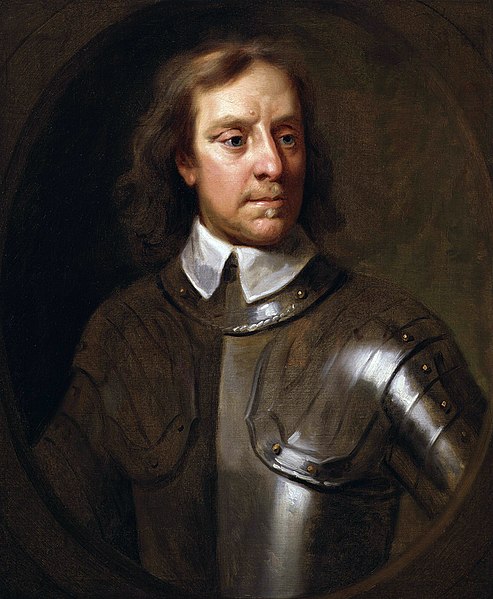
Oliver Cromwell In 1645 Parliament reaffirmed its determination to fight the war to a finish. It passed the Self-denying Ordinance, by which all members of either House of Parliament laid down their commands, and re-organized its main forces into the New Model Army ("Army"), under the command of Sir Thomas Fairfax, with Cromwell as his second-in-command and Lieutenant-General of Horse.[84] In two decisive engagements—the Battle of Naseby on 14 June and the Battle of Langport on 10 July—the Parliamentarians effectively destroyed Charles' armies.[85] In the remains of his English realm Charles attempted to recover a stable base of support by consolidating the Midlands. He began to form an axis between Oxford and Newark on Trent in Nottinghamshire. Those towns had become fortresses and showed more reliable loyalty to him than to others. He took Leicester, which lies between them, but found his resources exhausted. Having little opportunity to replenish them, in May 1646 he sought shelter with a Presbyterian Scottish army at Southwell in Nottinghamshire.[86] Charles was eventually handed over to the English Parliament by the Scots and was imprisoned.[87] This marked the end of the First English Civil War. The Second English Civil War Second English Civil War 
"And when did you last see your father?" by William Frederick Yeames. Charles I took advantage of the deflection of attention away from himself to negotiate a secret treaty with the Scots, again promising church reform, on 28 December 1647.[88] Under the agreement, called the "Engagement", the Scots undertook to invade England on Charles' behalf and restore him to the throne on condition of the establishment of Presbyterianism for three years. A series of Royalist uprisings throughout England and a Scottish invasion occurred in the summer of 1648. Forces loyal to Parliament[90] put down most of the uprisings in England after little more than skirmishes, but uprisings in Kent, Essex and Cumberland, the rebellion in Wales, and the Scottish invasion involved the fighting of pitched battles and prolonged sieges.[88] In the spring of 1648 unpaid Parliamentarian troops in Wales changed sides. Colonel Thomas Horton defeated the Royalist rebels at the Battle of St Fagans (8 May)[91]and the rebel leaders surrendered to Cromwell on 11 July after the protracted two-month siege of Pembroke.[92] Sir Thomas Fairfax defeated a Royalist uprising in Kent at the Battle of Maidstone on 1 June. Fairfax, after his success at Maidstone and the pacification of Kent, turned northward to reduce Essex, where, under their ardent, experienced and popular leader Sir Charles Lucas, the Royalists had taken up arms in great numbers. Fairfax soon drove the enemy into Colchester, but his first attack on the town met with a repulse and he had to settle down to a long siege.[93] In the North of England, Major-General John Lambert fought a very successful campaign against a number of Royalist uprisings—the largest that of Sir Marmaduke Langdale in Cumberland.[94] Thanks to Lambert's successes, the Scottish commander, the Duke of Hamilton, had perforce to take the western route through Carlisle in his pro-Royalist Scottish invasion of England.[95] The Parliamentarians under Cromwell engaged the Scots at the Battle of Preston (17–19 August). The battle took place largely at Walton-le-Dale near Preston in Lancashire, and resulted in a victory by the troops of Cromwell over the Royalists and Scots commanded by Hamilton.[95] This Parliamentarian victory marked the end of the Second English Civil War. Nearly all the Royalists who had fought in the First Civil War had given their parole not to bear arms against the Parliament, and many honourable Royalists, like Lord Astley, refused to break their word by taking any part in the second war. So the victors in the Second Civil War showed little mercy to those who had brought war into the land again. On the evening of the surrender of Colchester, Parliamentarians had Sir Charles Lucas and Sir George Lisle shot.[96] Parliamentary authorities sentenced the leaders of the Welsh rebels, Major-General Rowland Laugharne, Colonel John Poyer and Colonel Rice Powel to death, but executed Poyer alone (25 April 1649), having selected him by lot.[97] Of five prominent Royalist peers who had fallen into the hands of Parliament, three, the Duke of Hamilton, the Earl of Holland, and Lord Capel, one of the Colchester prisoners and a man of high character, were beheaded at Westminster on 9 March.[98] [edit]Trial of Charles I for treason The betrayal by Charles caused Parliament to debate whether to return the King to power at all. Those who still supported Charles' place on the throne tried once more to negotiate with him.[99] Furious that Parliament continued to countenance Charles as a ruler, the Army marched on Parliament and conducted "Pride's Purge" (named after the commanding officer of the operation, Thomas Pride) in December 1648.[100] Troops arrested 45 Members of Parliament and kept 146 out of the chamber. They allowed only 75 Members in, and then only at the Army's bidding. This Rump Parliament received orders to set up, in the name of the people of England, a High Court of Justice for the trial of Charles I for treason.[101] At the end of the trial the 59 Commissioners (judges) found Charles I guilty of high treason, as a "tyrant, traitor, murderer and public enemy".[102][103] His beheading took place on a scaffold in front of theBanqueting House of the Palace of Whitehall on 30 January 1649.[104] After the Restoration in 1660, of the surviving regicides not living in exile nine were executed and most of the rest sentenced to life imprisonment. Third English Civil War Ireland Cromwellian conquest of Ireland 
A 19th century representation of the Massacre at Drogheda, 1649 Ireland had known continuous war since the rebellion of 1641, with most of the island controlled by the Irish Confederates. Increasingly threatened by the armies of the English Parliament after Charles I's arrest in 1648, the Confederates signed a treaty of alliance with the English Royalists. The joint Royalist and Confederate forces under the Duke of Ormonde attempted to eliminate the Parliamentary army holding Dublin, but their opponents routed them at the Battle of Rathmines (2 August 1649).[108] As the former Member of Parliament Admiral Robert Blake blockaded Prince Rupert's fleet in Kinsale, Oliver Cromwell could land at Dublin on 15 August 1649 with an army to quell the Royalist alliance in Ireland.[109] Cromwell's suppression of the Royalists in Ireland during 1649 still has a strong resonance for many Irish people. After the siege of Drogheda,[109] the massacre of nearly 3,500 people — comprising around 2,700 Royalist soldiers and 700 others, including civilians, prisoners, and Catholic priests (Cromwell claimed all the men were carrying arms) — became one of the historical memories that has driven Irish-English and Catholic-Protestant strife during the last three centuries. The Parliamentarian conquest of Ireland ground on for another four years until 1653, when the last Irish Confederate and Royalist troops surrendered. The victors confiscated almost all Irish Catholic-owned land in the wake of the conquest and distributed it to the Parliament's creditors, to the Parliamentary soldiers who served in Ireland, and to English people who had settled there before the war. Scotland in the Wars of the Three Kingdoms The execution of Charles I altered the dynamics of the Civil War in Scotland, which had raged between Royalists and Covenanters since 1644. By 1649, the struggle had left the Royalists there in disarray and their erstwhile leader, the Marquess of Montrose, had gone into exile. At first, Charles II encouraged Montrose to raise a Highland army to fight on the Royalist side.[112] However, when the Scottish Covenanters (who did not agree with the execution of Charles I and who feared for the future of Presbyterianism and Scottish independence under the new Commonwealth) offered him the crown of Scotland, Charles abandoned Montrose to his enemies. However, Montrose, who had raised a mercenary force in Norway,[112] had already landed and could not abandon the fight. He did not succeed in raising many Highland clans and the Covenanters defeated his army at the Battle of Carbisdale in Ross-shire on 27 April 1650. The victors captured Montrose shortly afterwards and took him to Edinburgh. On 20 May the Scottish Parliament sentenced him to death and had him hanged the next day. 
"Cromwell at Dunbar", by Andrew Carrick Gow Charles II landed in Scotland at Garmouth in Morayshire on 23 June 1650[114] and signed the 1638 National Covenant and the 1643 Solemn League and Covenantshortly after coming ashore.[115] With his original Scottish Royalist followers and his new Covenanter allies, King Charles II became the greatest threat facing the new English republic. In response to the threat, Cromwell left some of his lieutenants in Ireland to continue the suppression of the Irish Royalists and returned to England.[113] He arrived in Scotland on 22 July 1650[116] and proceeded to lay siege to Edinburgh. By the end of August disease and a shortage of supplies had reduced his army, and he had to order a retreat towards his base at Dunbar. A Scottish army, assembled under the command of David Leslie, tried to block the retreat, but Cromwell defeated them at the Battle of Dunbar on 3 September.[117] Cromwell's army then took Edinburgh, and by the end of the year his army had occupied much of southern Scotland. In July 1651, Cromwell's forces crossed the Firth of Forth into Fife and defeated the Scots at the Battle of Inverkeithing (20 July 1651).[118] The New Model Army advanced towards Perth, which allowed Charles, at the head of the Scottish army, to move south into England. Cromwell followed Charles into England, leaving George Monck to finish the campaign in Scotland. Monck took Stirling on 14 August and Dundee on 1 September.[119] The next year, 1652, saw the mopping up of the remnants of Royalist resistance, and under the terms of the "Tender of Union", the Scots received 30 seats in a united Parliament in London, with General Monck appointed as the military governor of Scotland. England Although Cromwell's New Model Army had defeated a Scottish army at Dunbar, Cromwell could not prevent Charles II from marching from Scotland deep into England at the head of another Royalist army.[121]The Royalists marched to the west of England because English Royalist sympathies were strongest in that area, but although some English Royalists joined the army, they came in far fewer numbers than Charles and his Scottish supporters had hoped. Cromwell finally engaged and defeated the new king at Worcester on 3 September 1651.[112] Charles II escaped, via safe houses and a famous oak tree, to France, ending the civil wars. Political control During the Wars, the Parliamentarians established a number of successive committees to oversee the war-effort. The first of these, the Committee of Safety, set up in July 1642, comprised 15 Members of Parliament.[122] Following the Anglo-Scottish alliance against the Royalists, the Committee of Both Kingdoms replaced the Committee of Safety between 1644 and 1648.[123] Parliament dissolved the Committee of Both Kingdoms when the alliance ended, but its English members continued to meet and became known as the Derby House Committee.[123] A second Committee of Safety then replaced that committee. 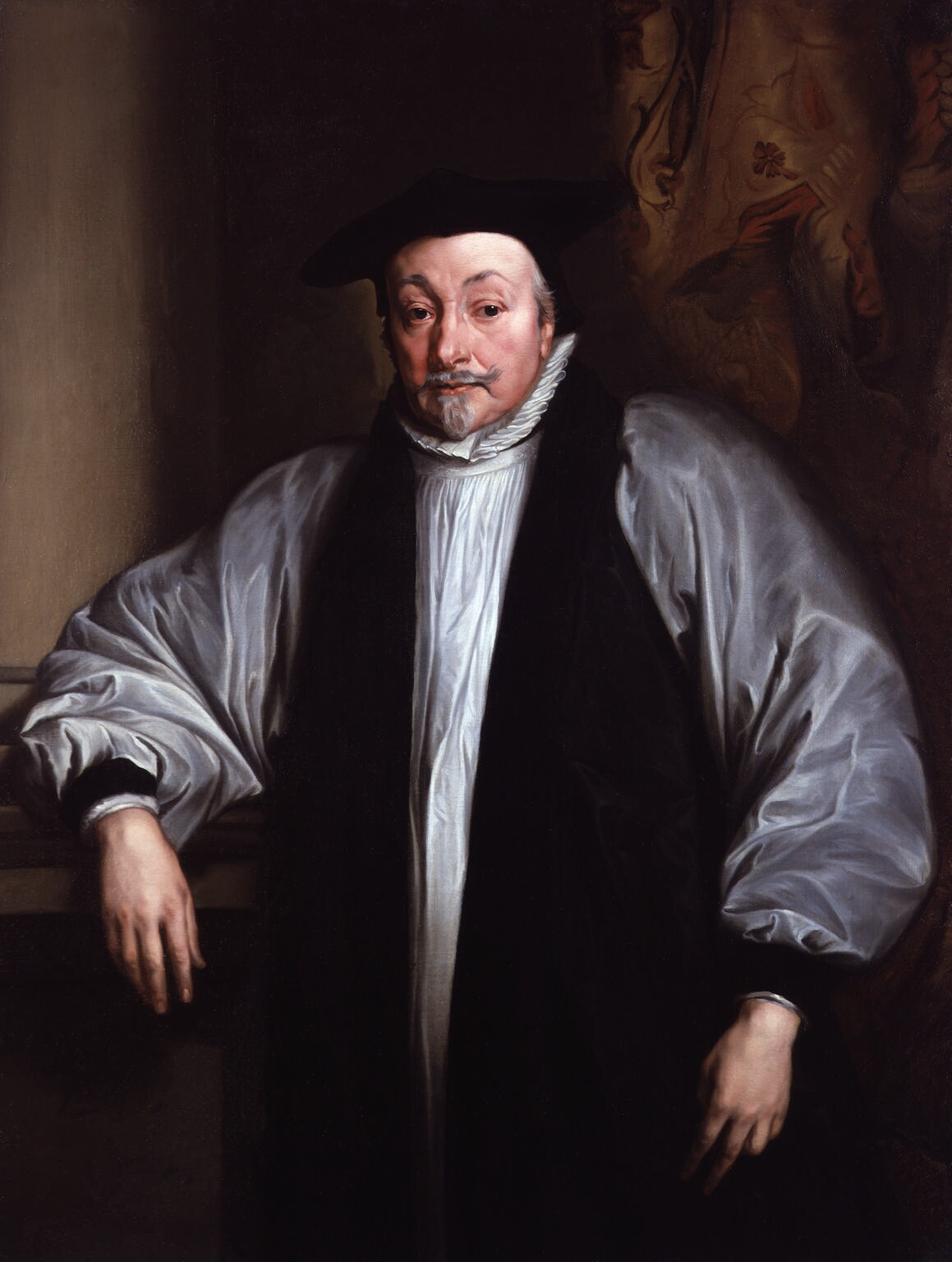
William Laud, Charles I's Archbishop of Canterbury. During the period of the English Civil War, the role of bishops as wielders of political power and as upholders of the established church became a matter of heated political controversy. John Calvin formulated a doctrine of Presbyterianism, which held that in the New Testament the offices of presbyter and episkopos were identical; he rejected the doctrine of apostolic succession. Calvin's follower John Knox brought Presbyterianism to Scotland when the Scottish church was reformed in 1560. In practice, Presbyterianism meant that committees of lay elders had a substantial voice in church government, as opposed to merely being subjects to a ruling hierarchy. This vision of at least partial democracy in ecclesiology paralleled the struggles between Parliament and the King. A body within the Puritan movement in the Church of England sought to abolish the office of bishop and remake the Church of England along Presbyterian lines. The Martin Marprelate tracts, applying the pejorative name ofprelacy to the church hierarchy, attacked the office of bishop with satire that deeply offended Elizabeth I and her Archbishop of Canterbury John Whitgift. The vestments controversy also related to this movement, seeking further reductions in church ceremony, and labelling the use of elaborate vestments as "unedifying" and evenidolatrous. King James I, reacting against the perceived contumacy of his Presbyterian Scottish subjects, adopted "No Bishop, no King" as a slogan; he tied the hierarchical authority of the bishop to the absolute authority he sought as king, and viewed attacks on the authority of the bishops as attacks on his own authority. Matters came to a head when King Charles I appointed William Laud as the Archbishop of Canterbury; Laud aggressively attacked the Presbyterian movement and sought to impose the full Anglican liturgy. The controversy eventually led to Laud's impeachment for treason by a bill of attainder in 1645, and subsequent execution. Charles also attempted to impose episcopacy on Scotland; the Scots' violent rejection of bishops and liturgical worship sparked the Bishops' Wars in 1639–1640. During the height of Puritan power in the Commonwealth and the Protectorate, episcopacy was formally abolished in the Church of England on 9 October 1646.[124] The Church of England remained Presbyterian until the Restoration of the monarchy with Charles II in 1660.[125] [edit]Casualties As usual in wars of this era, disease caused more deaths than combat. There are no accurate figures for these periods, and it is not possible to give a precise overall figure for those killed in battle, as opposed to those who died from disease, or even from a natural decline in population. Figures for casualties during this period are unreliable, but some attempt has been made to provide rough estimates.[126][127] In England, a conservative estimate is that roughly 100,000 people died from war-related disease during the three civil wars. Historical records count 84,830 dead from the wars themselves. Counting in accidents and the two Bishops' wars, an estimate of 190,000 dead is achieved,[128] out of a total population of about five million.[129] Figures for Scotland are more unreliable and should be treated with greater caution. Casualties include the deaths of prisoners-of-war in conditions that accelerated their deaths, with estimates of 10,000 prisoners not surviving or not returning home (8,000 captured during and immediately after the Battle of Worcester were deported to New England, Bermuda and the West Indies to work for landowners asindentured labourers[130]). There are no figures to calculate how many died from war-related diseases, but if the same ratio of disease to battle deaths from English figures is applied to the Scottish figures, a not unreasonable estimate of 60,000 people is achieved,[131] from a population of about one million.[129] Figures for Ireland are described as "miracles of conjecture". Certainly the devastation inflicted on Ireland was unbelievable, with the best estimate provided by Sir William Petty, the father of English demography. Petty estimates that 112,000 Protestants were killed through plague, war and famine, and that 504,000 Catholics were killed, giving an estimated total of 616,000 dead,[132] from a pre-war population of about one and a half million.[129] Although Petty's figures are the best available, they are still acknowledged as being tentative; they do not include the estimate of 40,000 driven into exile, some of whom served as soldiers in European continental armies, while others were sold as indentured servants to New England and the West Indies. Many of those sold to landowners in New England eventually prospered, but many of those sold to landowners in the West Indies were worked to death. These estimates indicate that England suffered a 3.7% loss of population, Scotland a loss of 6%, while Ireland suffered a loss of 41% of its population. Putting these numbers into the context of other catastrophes helps to understand the devastation to Ireland in particular. The Great Hunger of 1845–1852 resulted in a loss of 16% of the population, while during the Second World War the population of the Soviet Union fell by 16%.[133] [edit]Popular gains Ordinary people took advantage of the dislocation of civil society during the 1640s to derive advantages for themselves. The contemporary guild democracy movement won its greatest successes among London's transport workers, notably the Thames watermen.[134] Rural communities seized timber and other resources on the sequestrated estates of royalists and Catholics, and on the estates of the royal family and the church hierarchy. Some communities improved their conditions of tenure on such estates.[135] The old status quo began a retrenchment after the end of the First Civil War in 1646, and more especially after the restoration of monarchy in 1660. But some gains were long-term. The democratic element introduced in the watermen's company in 1642, for example, survived, with vicissitudes, until 1827.[136] [edit]Aftermath The wars left England, Scotland, and Ireland among the few countries in Europe without a monarch. In the wake of victory, many of the ideals (and many of the idealists) became sidelined. The republican government of the Commonwealth of England ruled England (and later all of Scotland and Ireland) from 1649 to 1653 and from 1659 to 1660. Between the two periods, and due to in-fighting amongst various factions in Parliament, Oliver Cromwell ruled over the Protectorate as Lord Protector (effectively a military dictator) until his death in 1658.[137] Upon his death, Oliver Cromwell's son Richard became Lord Protector, but the Army had little confidence in him.[138] After seven months the Army removed Richard, and in May 1659 it re-installed the Rump.[139]However, since the Rump Parliament acted as though nothing had changed since 1653 and as though it could treat the Army as it liked, military force shortly afterwards dissolved this, as well.[140] After the second dissolution of the Rump, in October 1659, the prospect of a total descent into anarchy loomed as the Army's pretence of unity finally dissolved into factions. 
A historical civil war re-enactment Into this atmosphere General George Monck, Governor of Scotland under the Cromwells, marched south with his army from Scotland. On 4 April 1660, in the Declaration of Breda, Charles II made known the conditions of his acceptance of the Crown of England.[142] Monck organised the Convention Parliament,[143] which met for the first time on 25 April 1660. On 8 May 1660, it declared that King Charles II had reigned as the lawful monarch since the execution of Charles I in January 1649. Charles returned from exile on 23 May 1660. On 29 May 1660, the populace in London acclaimed him as king.[144] His coronation took place at Westminster Abbey on 23 April 1661. These events became known as the Restoration. Although the monarchy was restored, it was still only with the consent of Parliament; therefore, the civil wars effectively set England and Scotland on course to adopt aparliamentary monarchy form of government.[146] This system would result in the outcome that the future Kingdom of Great Britain, formed in 1707 under the Acts of Union, would manage to forestall the kind of often-bloody revolution, typical of European republican movements that followed the Jacobin revolution in 18th century France and the later success of Napoleon, which generally resulted in the total abolition of monarchy. It was no coincidence that the United Kingdom was spared the wave of revolutions that occurred in Europe in the 1840s. | 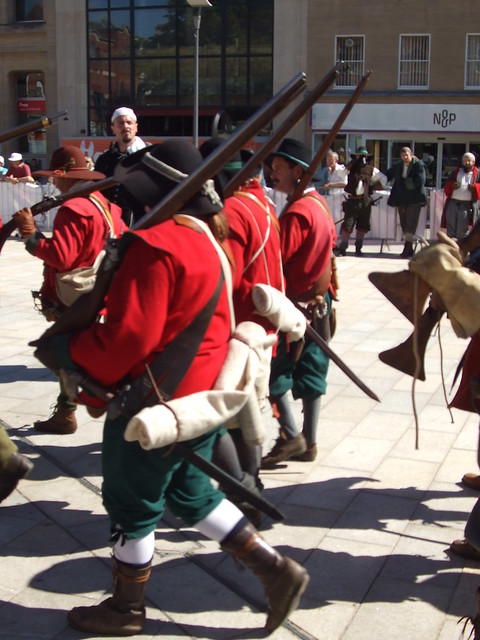
English Civil War English Civil War - Sealed Knot - Earl of Manchester's Regiment 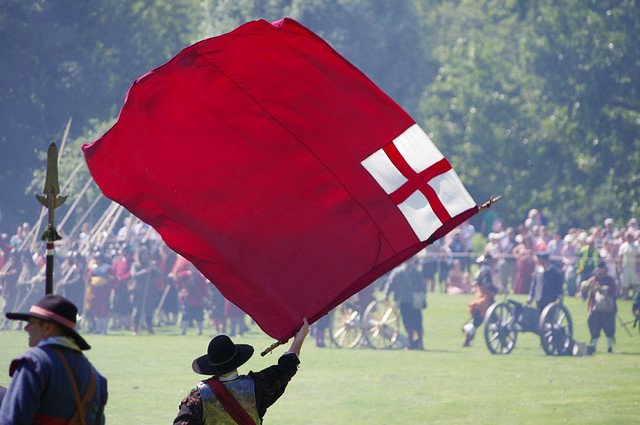
English Civil War - These colours don't run! 
Into Battle An English Civil War 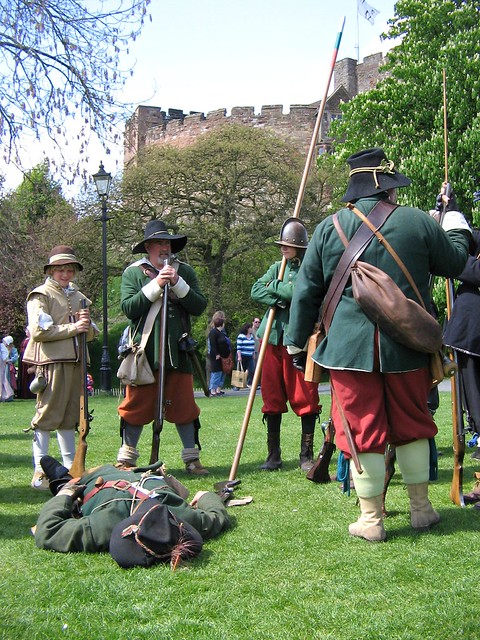
Tamworth - English Civil War English The Sealed Knot camp in Tamworth Castle grounds. 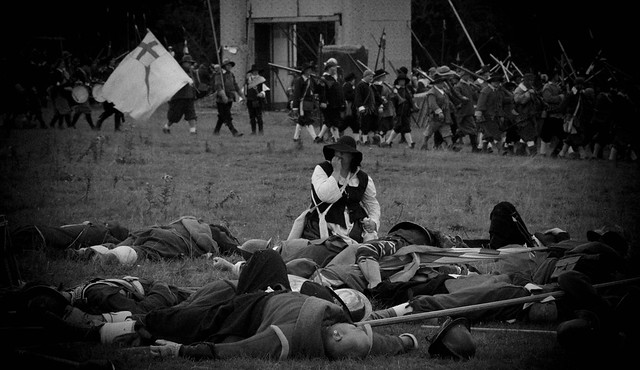
The Fall of Basing House in the English Civil War: The victorious Parliamentarians march past the slain defenders in a re-enactment by the Sealed Knot. The Civil War was all but lost for King Charles when Basing House was besieged for the third and last time. In August 1645 the Dutch siege engineer Colonel John Dalbier arrived at Basing with about 800 Parliamentary troops. He was soon joined by a company of soldiers from Reading, and later by a hundred musketeers from Southwark. Dalbier spent a month scientifically planning his attack. He then went into action with devastating effect, causing much more severe damage than the previous random bombardment. He even tried an early form of poison gas, burning wet straw mixed with sulphur and arsenic upwind of the house. About a fortnight after Dalbier commenced his onslaught he was joined by Oliver Cromwell, who brought state of the art heavy artillery. His largest gun is thought to have fired shot weighing between forty-eight and sixty-three pounds. On Friday 10 October 1645 Cromwell and Dalbier commenced a concerted artillery bombardment. By Monday evening the walls of Basing House were well and truly breached. At dawn the following morning the Parliamentarians made their final attack, spurred on by rumours of treasure stored in the House and tales of numerous Catholic priests harboured there. The storming of the house was ferocious. Between forty and a hundred of the inmates were killed, including six Catholic priests and many noblemen. The Parliamentary soldiers were given free rein to pillage Basing House. The loot was estimated to be worth about £200,000 (about £10m today). The troops raided the cellars and it may have been here that the fire started that burned for twenty hours and completed the destruction of the palatial fortress. 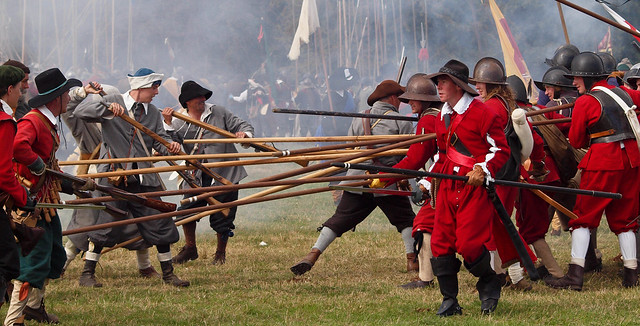
Pikemen engage musketeers during a re-enactment of the Siege of Basing House, an event in the English Civil War. Musketeers were often forced to use their muzzle loading firearms as clubs because a tactic of Pikemen was to charge before their opponents had time to reload. 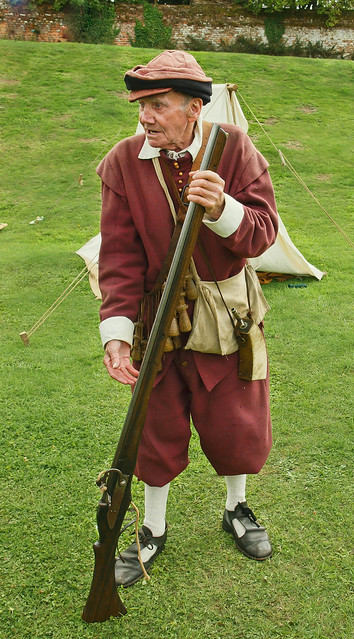
A veteran of the Sealed Knot, an English Civil War re-enactment group, demonstrates his matchlock musket 
Members of the Sealed Knot stroll past the 16th Century dovecote in the walled garden of Basing House, the site of a battle in the English Civil War 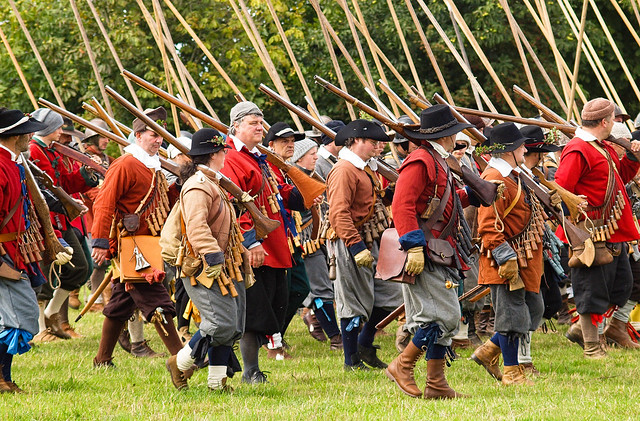
Musketeers and Pikemen of the Sealed Knot march to battle at a re-enactment of the Siege of Basing House, an event in the English Civil War The hardwood bottles hanging from the musketeer's bandoliers held individual charges of black powder for their muzzle loading weapons 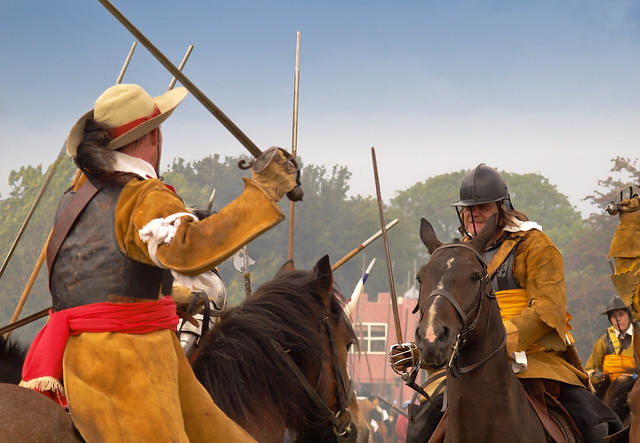
Cavalier vs Roundhead: Members of the Sealed Knot re-enact the Siege of Basing House, an event in the English Civil War 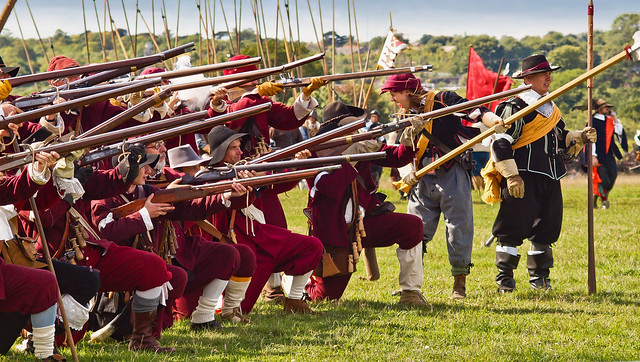
Musketeers of the Sealed Knot discharge their weapns at a re-enactment of the Siege of Basing House, an event in the English Civil War 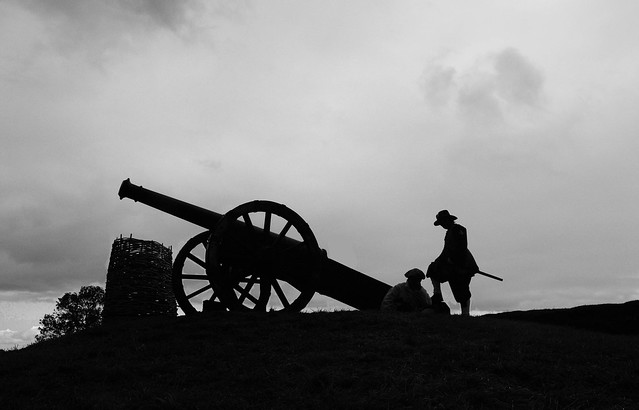
Members of The Sealed Knot and their cannon in a re-enactment of the Siege of Basing House, an event in the English Civil War 
Cavalrymen of The Sealed Knot re-enact the Siege of Basing House, an event in the English Civil War 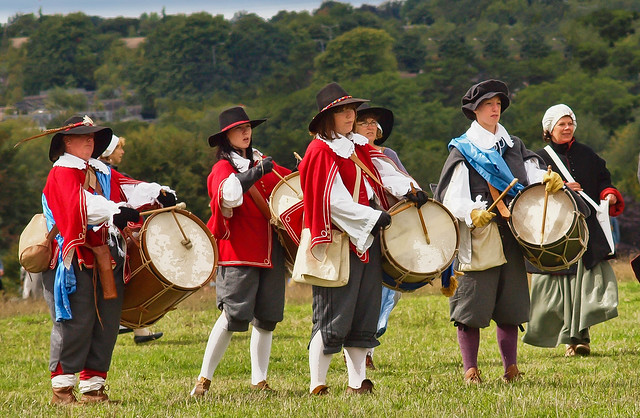
Drummers of The Sealed Knot encourage their troops in a re-enactment of the Siege of Basing House, an event in the English Civil War 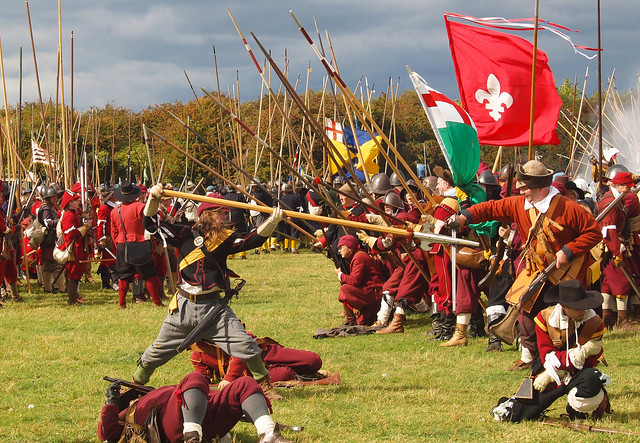
A Pikeman of The Sealed Knot attacks in a re-enactment of the Siege of Basing House, an event in the English Civil War 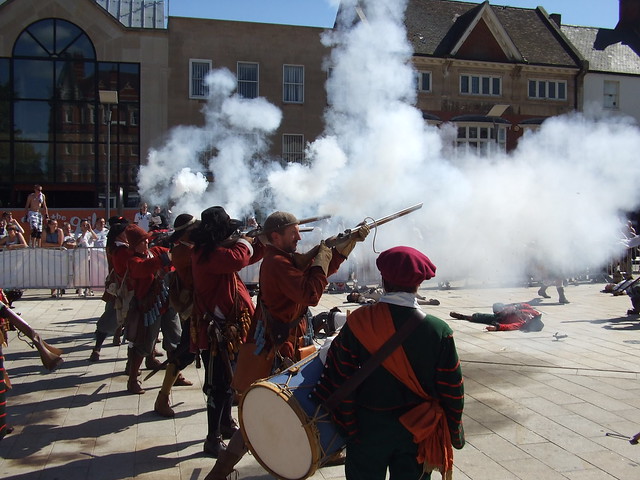
English Civil War 
The English Civil War 
The English Civil War 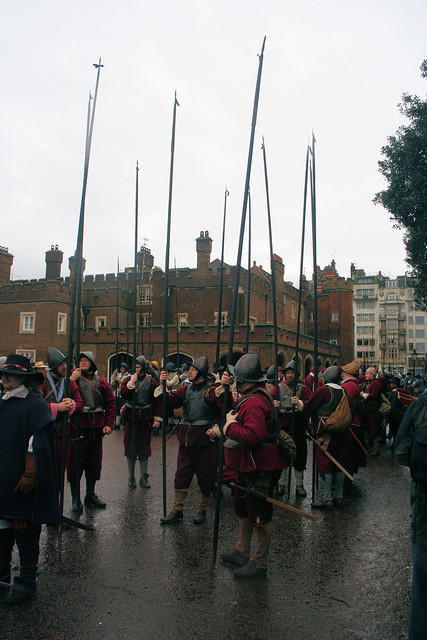
English Civil War Society Remember the "murder" of King Charles I 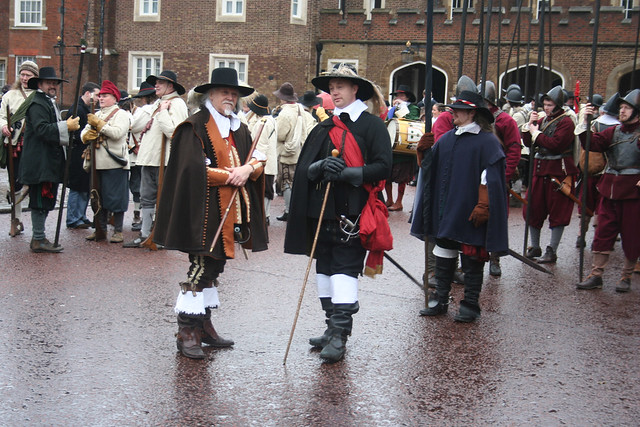
English Civil War Society Remember the "murder" of King Charles I | |

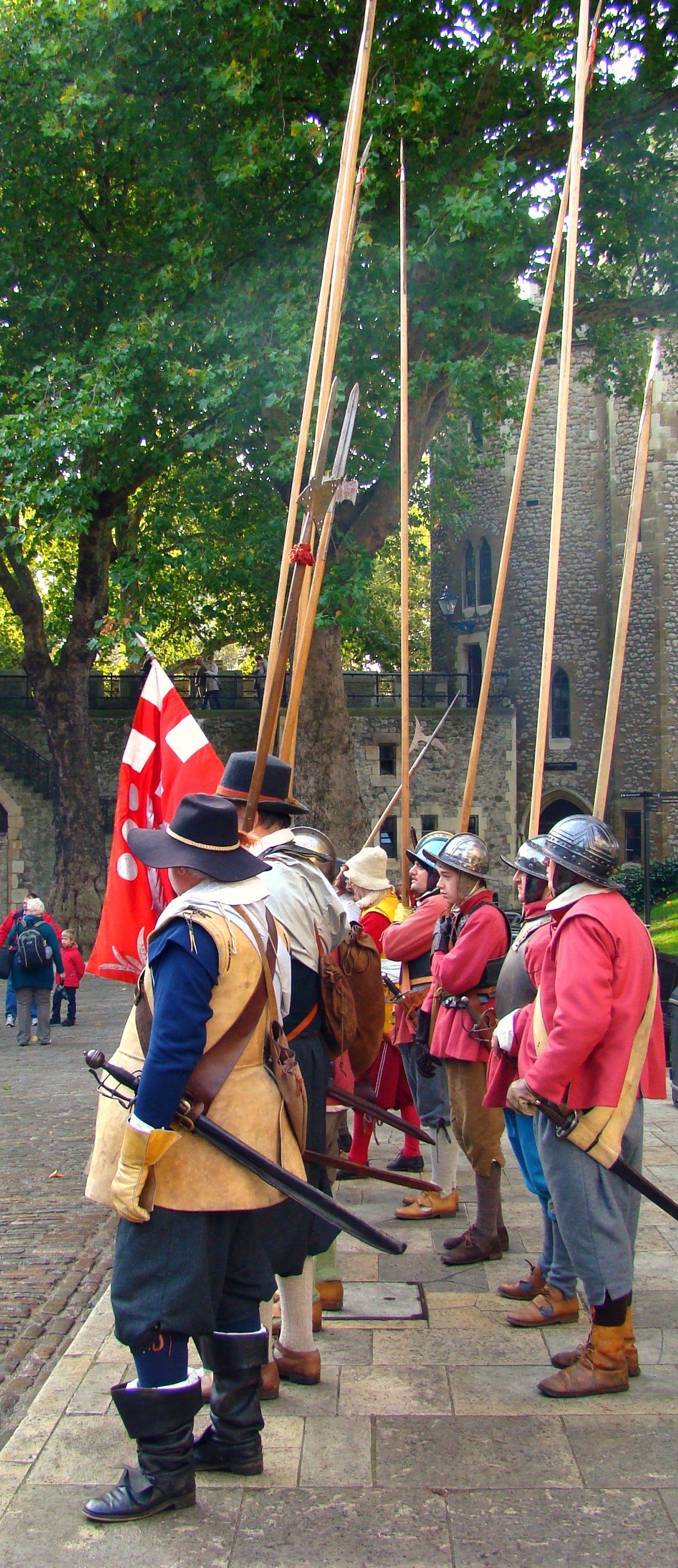

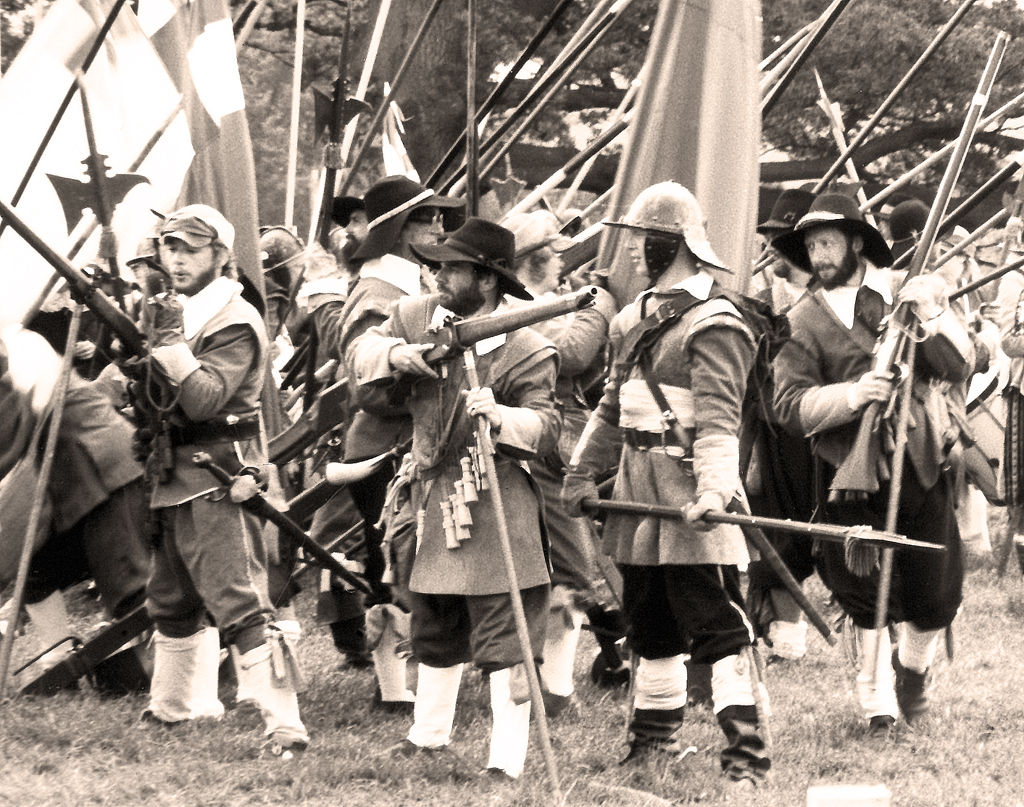





































No comments:
Post a Comment